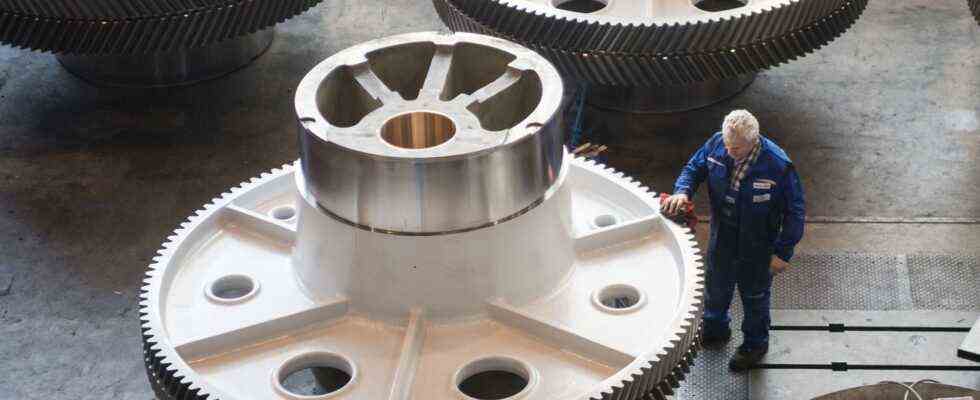Status: 07.09.2021 3:10 p.m.
Economic output in the eurozone rose more sharply than experts expected in the second quarter. The economic recovery appears to be in full swing. But risks and doubts persist.
The gross domestic product of the euro area grew by 2.2 percent between April and June. In announcing this growth rate, the Eurostat statistical office corrected its earlier estimate by 0.2 percentage points upwards.
At the beginning of the year, the eurozone economy had shrunk by 0.3 percent compared to the final quarter of 2020 – at the end of 2020 by as much as 0.4 percent. The extent to which the euro economy caught up with the economic downturn in the previous year is evident in a comparison with the previous year: In the second quarter of 2021, the gross domestic product was a revised 14.3 percent higher than in the second quarter of 2020.
Italy and Spain with more dynamism
A look at the individual member states of the euro zone, however, shows a different dynamic in the economic recovery: Among the four largest economies in the currency area, the Spanish one grew particularly strongly between April and June. The GDP there increased by 2.8 percent compared to the period from January to March. The Italian economy grew by 2.7 percent, while the growth of the German economy at 1.6 percent and the French economy at 1.1 percent were noticeably weaker. The absolute growth leaders in the quarter were Ireland (plus 6.3 percent) and Portugal (plus 4.9 percent). In Malta and Croatia, on the other hand, economic output even contracted slightly.
There are several reasons for the inequality in growth. Economies such as Spain and Austria, where GDP grew by 3.6 percent, benefited from the resumption of tourism in the months of April to June. Countries such as Germany, Denmark or Sweden are now recording low growth because the corona kink was less pronounced here last year.
Corona aid fund is having an impact
In addition, the first effects of the Corona aid fund are likely to be felt in large economies in the euro area. Italy is the largest recipient of the funds from the € 750 billion package and receives around € 191 billion. The Italian government expects economic growth of at least 5.8 percent compared to 2020, also because of the corona aid. Spain and France also receive high billions from the fund, about half of which consists of non-repayable grants . The federal states have up to 30 years to repay the loans.
The coming quarters will show whether the funds from the aid fund will stimulate growth in the recipient countries over the long term. The economic recovery could also turn out to be fragile if a fourth corona wave should again lead to stronger restrictions in public life and travel.
Euro area not yet at pre-crisis level
Even if the euro economy is now growing again: Based on seasonally adjusted figures, GDP was still 2.5 percent below its highest value in the fourth quarter of 2019 – i.e. before the outbreak of the pandemic. In the USA, the economic recovery is already further advanced: In the spring, GDP there was 0.8 percent above the level of the final quarter of 2019.
The EU Commission is forecasting an increase of 4.8 percent in GDP in the eurozone for the current year. According to Economic Commissioner Paolo Gentiloni, growth could be even higher. The mood among the companies is good. The economy has apparently learned to live with the weakened pandemic restrictions.
Financial experts expect cooling
The mood among many financial experts is apparently not nearly as good for the coming months, as the ZEW index of economic expectations, which the Center for European Economic Research published in the morning, shows. The surveyed financial professionals, analysts and economists are now more likely to assume an economic slowdown: The mood barometer fell by 13.9 points compared to the previous month to 26.5 points. In May, the indicator had reached its highest level in a good two decades. Since then, the indicator has fallen four times in a row. “The shortage of chips in vehicle construction and the scarcity of resources in the construction industry have led to a significant decline in earnings expectations in these industries,” explained ZEW President Achim Wambach.
In contrast, the assessment of the current situation improved slightly in September. The indicator rose by 2.6 points to 31.9 points. The experts questioned assumed that the economic situation would improve. However, according to Wambach, the expected extent and the dynamics of the improvement have since been significantly reduced. Bank economists interpreted the development as an indication of an impending economic slowdown. “The course has been set for cooling,” explained Thomas Gitzel, chief economist at Liechtenstein’s VP Bank.

